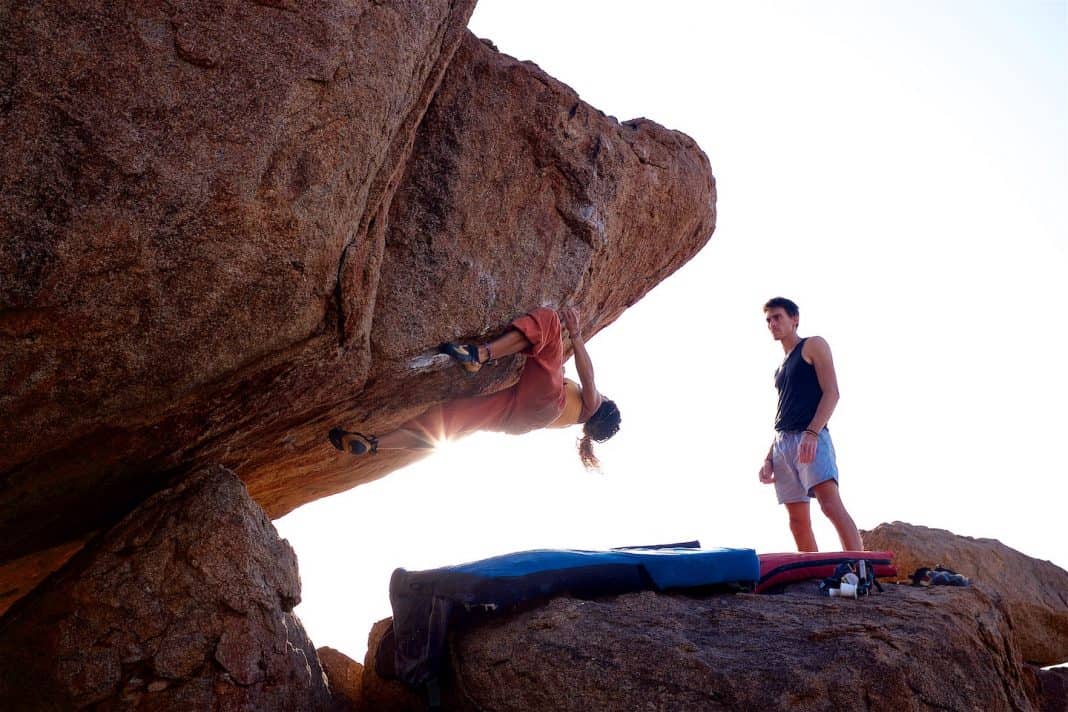Gripping neon moldings, hanging upside down, arms quivering, scanning the wall for where you’re going to plant your hand next—not exactly the badass image you had in mind when you decided to try bouldering. That’s probably many climbers’ first experience with ropeless rock climbing, though. You might envision yourself straight out of a North Face ad, scaling a mountain, but it takes time to get the hang of anything. With a little work, though, a realistic version of that image might be possible, and it’ll be worth it for your mind and body.
First Things First: What is bouldering?
Is that even a verb? Yes. To quote REI, “Bouldering is climbing in its simplest form, sans ropes, harnesses, and hardware on rock faces that are shorter than the walls at cragging areas.” The route to the top of a boulder outside or wall inside is called a problem, and the climber’s goal is to find the solution—that is, how to get to the top.
Why should I try bouldering?
Physically, bouldering is pretty much a full-body workout. Not only do you work out your arms, but you also use your back, shoulders, core, and leg strength to move yourself up. While at first glance bouldering would be considered a strength exercise, any type of rock climbing is also considered a cardio workout. A 2004 study concludes, “During climbing, there are increases in oxygen consumption and heart rate, suggesting that it requires utilisation of a significant portion of whole body aerobic capacity.” Increased oxygen intake (aerobics) happens simultaneously with increased heart rate (cardio). Besides that, watching pros climb, you can see that bouldering requires that you bend your body in ways you wouldn’t ordinarily, boosting flexibility. https://www.instagram.com/p/BhtkcXLDe92/?taken-by=shaunacoxsey Mentally, there’s some problem solving involved, hence why the climbs are called problems. In addition to using your mind strategically, bouldering is also an exercise in mindfulness. This kind of mindfulness therapy can treat mental health disorders, with one study proving that bouldering helped mitigate symptoms of depression. Sounds like a win-win to me. Socially, you can also get the benefit of working out with others. Climbing gym communities can be pretty tight-knit, and watching each other try to scale (and fall) makes the individual activity more social than you might expect.
Where can I get started?
If hopping on a boulder outside seems a little daunting as a beginner, start out at a climbing gym. Gyms usually mark the grips for different problems and label sections for varying difficulties. Plus, there are mats around the gym to make the falls somewhat less traumatizing, plus knowledgeable employees you can [linkbuilder id=”6572″ text=”ask for help”]. The popularity of climbing gyms has continued to grow steadily, so most sizeable towns should have an option for indoor bouldering. Inside, you can master some of the basic skill sets before venturing outdoors. Like lots of fitness activities, the gym’s expert climbers might intimidate you as a novice, but odds are they’ll be welcoming and might even teach you a thing or two. Still, you can start out in a class or join a beginner group. Once you do make it outside (if that’s one of your goals!), the possibilities are plentiful. Since bouldering doesn’t require great heights, even non-mountainous regions have areas outside where you can try it. You can do a little internet searching, but asking around at your local climbing gym might be the best bet for finding safe spots for beginners.
What gear do I need for my first bouldering sesh?
Especially if you’re going outside, where rentals aren’t likely, it’s best to invest in some essential gear.
- Crash Pads (for outdoor bouldering): Not as scary as they sound, crash pads are just mats, like gyms have inside, to catch you when you fall.
- Climbing Shoes: You can rent these at most gyms, but if you decide you like bouldering, it’ll pay off to invest in a pair.
- Chalk and Chalk Bag: Chalk dries up any moisture on your hands and improves your grip.
- Spotters: i.e. friends who will be there to catch you when you fall and yell words of encouragement as you climb.
What’s next, boulder babe?
Getting into new fitness activities can be a little daunting, but if you’re in a workout rut or simply want to find a new hobby, bouldering is a super badass way to shake up your routine. The first time I bouldered was a haphazard attempt on a service trip in Appalachia that proved to be a physical challenge and a great bonding experience. To make yourself a bit more comfortable prior to your first climb, read up on some basic tips and terminology so you have some understanding of what’s going on around you. Then try it out for yourself!



